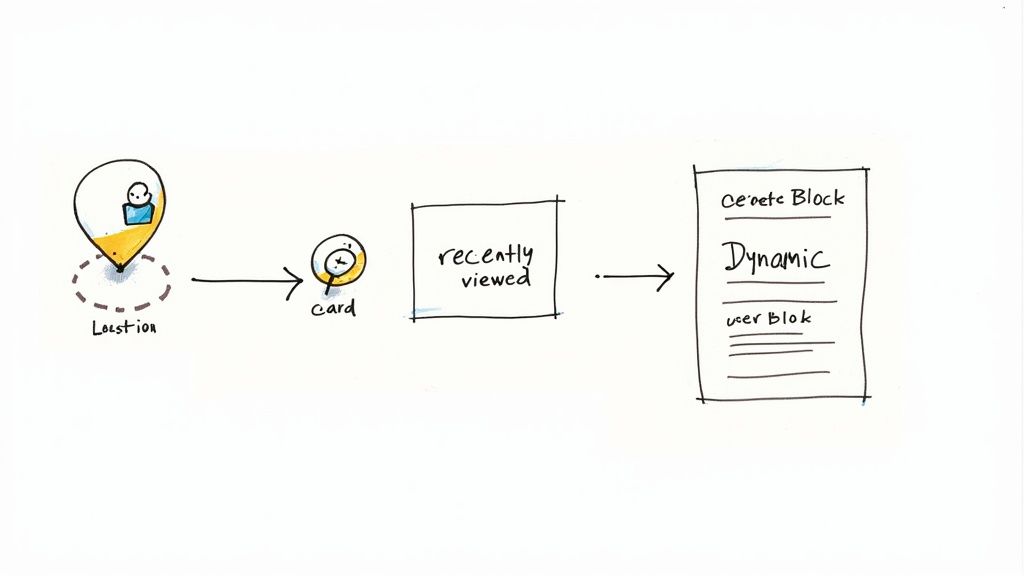
website personalization
what is website personalization: Boost Engagement
Posted on Nov 10, 2025

You know that feeling when you walk into your favorite local coffee shop, and the barista starts making your usual order before you even say a word? That’s the kind of effortless, intuitive service that builds loyalty.
Website personalization is the digital version of that exact experience. It’s all about creating customized, relevant journeys for every single person who lands on your site, tailoring the content and offers to what they actually want and need.
What is Website Personalization, Really?

Think of it like having an expert personal shopper for your website. A great one doesn't just throw random clothes at you. They take the time to understand your style, look at what you’ve bought before, and listen to what you're looking for right now.
A personalized website does the same thing, using data to craft a one-of-a-kind experience for every visitor. We’re not just talking about dropping a name into a "Welcome, [First Name]!" banner. Real personalization goes much deeper, using clues to make the entire visit feel like the site was built just for them.
The Magic Behind the Curtain: How it Works
So, how does a website "know" what a visitor is looking for? It’s not magic—it’s data. The site acts like a detective, gathering clues from a few key sources to build a picture of who the user is and what they want.
This data usually falls into three buckets:
- Behavioral Data: This is all about what they do. Which pages did they visit? What properties did they click on? How long did they stay? Did they add a specific rental to their favorites?
- Demographic Data: This covers the basics, like their general location (e.g., are they searching from a cold-weather city for a beach getaway?), their language, or the device they're using.
- Contextual Data: This looks at the "how" and "when" of their visit. Did they come from a Facebook ad about family-friendly cabins? Or an email about last-minute romantic escapes?
To get a clearer picture of how these pieces fit together, let's break down the inputs and outputs.
Key Elements of Website Personalization
| Data Input (What the Website Knows) | Personalized Output (What the Visitor Sees) |
|---|---|
| Location Data: Visitor is from New York City in winter. | Hero Image: A sunny beach photo with the headline "Escape the Cold!" |
| Referral Source: Visitor clicked a link from a travel blog about "Pet-Friendly Vacations." | Featured Properties: A curated list of rentals that allow pets. |
| Past Behavior: Visitor previously viewed 3-bedroom cabins with hot tubs. | Pop-up Offer: A special discount on a newly listed cabin with a hot tub. |
| Device Type: Visitor is browsing on a mobile phone. | Layout: A simplified, mobile-first design with large, easy-to-tap buttons. |
As you can see, by piecing together these different data points, a website can dynamically shift its content to create a genuinely helpful conversation.
This isn’t some futuristic concept; it’s quickly becoming the baseline expectation. In fact, a whopping 71% of consumers now expect companies to deliver personalized interactions. For more on this, check out the latest statistics from Adam Connell's in-depth research.
A personalized website makes visitors feel seen and understood. It anticipates their needs and guides them toward solutions, turning a passive browsing session into an active, engaging journey that builds trust and drives conversions.
This is just one way to deliver custom content at scale. If you're interested in similar automated strategies, you might want to read our guide on what programmatic SEO is and how it works.
Why Generic Websites No Longer Work

In today’s market, having a "one-size-fits-all" website is like putting up a silent billboard on a busy highway. Sure, it exists, but it’s not really grabbing anyone's attention. Modern guests expect more than a static online brochure; they want an experience that feels like it was made just for them.
Generic websites treat every single visitor the same, whether they're a first-timer browsing from a chilly climate or a loyal guest who only books mountain cabins. This approach forces everyone to see the same promotions and content, making them work harder to find what they actually want. It’s a fast track to a bad first impression.
This isn't just a minor annoyance—it directly hits your bottom line. When a potential guest feels misunderstood or has to dig for information, they’re far more likely to click away. That means higher bounce rates, less time spent on your site, and ultimately, lost bookings.
The Financial Case for a Tailored Experience
Shifting from a generic site to a personalized one isn't just a "nice-to-have" upgrade. It’s a core business strategy with a very real return on investment. The numbers don't lie.
In-house marketers who personalize their web experiences see an average 19% lift in sales. For retailers, the results are even more striking, with 70% reporting an ROI of at least 400% on their personalization efforts. You can dig into more of these stats in VWO's comprehensive personalization report.
Website personalization bridges the gap between what a visitor wants and what a business offers. It transforms the user journey from a generic monologue into a dynamic, one-on-one conversation that builds trust and drives action.
Beyond Conversions: Building Lasting Loyalty
The magic of what is website personalization goes well beyond just getting that first booking. By consistently delivering relevant content and offers, you create a much stickier experience that keeps guests coming back.
Think about it:
- Reduced Friction: A personalized site anticipates your guests' needs, showing them exactly what they’re looking for without the endless searching.
- Increased Trust: When a site remembers someone's preferences, it sends a powerful message: "We get you, and we value you."
- Higher Lifetime Value: A guest who feels understood is far more likely to book with you again and rave about your properties to their friends.
This approach turns a simple transaction into a lasting relationship, making personalization an essential tool for sustainable growth.
Core Website Personalization Techniques

Personalization isn't some black-box magic; it's really just a collection of smart, specific strategies that work together to create those "wow, this is exactly what I was looking for" moments. Once you pull back the curtain and see the individual techniques, the whole concept becomes much less mysterious.
Breaking these methods down shows you how each one contributes to a more relevant and engaging experience for your visitors. Some of the most powerful personalization plays are surprisingly simple, ranging from small tweaks based on a guest's location to more sophisticated displays that react to their on-site behavior. It’s all about making the journey to booking as smooth and intuitive as possible.
Foundational Personalization Tactics
The easiest wins in personalization often deliver the biggest impact right out of the gate. These foundational methods are straightforward and don't require massive amounts of data to get started. They simply use basic contextual clues to make a visitor's experience better, instantly.
Here are a few common starting points:
- Location-Based Content: This is a classic. Someone browsing your site from snowy Chicago in January sees your sunny, beachfront rentals first. It just makes sense. You're showing them what they're likely dreaming about.
- New vs. Returning Visitors: A simple "Welcome back!" message for a returning visitor goes a long way. It’s a small nod that shows you remember them, making them feel recognized and valued right from the start.
- Device-Specific Layouts: It sounds basic, but ensuring your site looks and works perfectly on a phone, tablet, or desktop is a form of personalization. You're tailoring the experience to their chosen device.
Think of these tactics as the building blocks for a solid personalization strategy. They establish a baseline of relevance that today's travelers simply expect.
Advanced Behavioral Techniques
Once you've nailed the basics, you can graduate to more advanced methods that tap into user behavior. These techniques use data from a visitor's actions—both in their current session and from past visits—to serve up incredibly targeted content. This is where you can really ramp up engagement and steer guests toward booking.
The ultimate goal of website personalization is to remove friction from the booking process. The easiest way to do that? Show visitors things they've already expressed an interest in. It helps them pick up right where they left off.
A powerful example is displaying recently viewed properties. If a guest spent time looking at a few specific mountain cabins, you should absolutely feature those properties on the homepage when they return. It keeps their interest high and their search alive.
Another great technique is using dynamic content, where banners, headlines, or calls-to-action change based on who's looking. You could, for instance, show a special offer only to visitors who have viewed more than five different properties, giving them that final nudge to book.
These strategies are at the heart of many successful conversion rate optimization techniques because they speak directly to what the user wants, making the path to booking feel less like a chore and more like a discovery.
Learning From Personalization Masters
Theory is one thing, but seeing **website personalization** in action is what really makes the concept click. To truly get a feel for its power, we can look at the brands that have woven personalization into the very fabric of their success.These companies aren't just dabbling; they're masters of the craft. They treat every single user interaction as a clue, collecting data points to build experiences that feel uniquely intuitive and genuinely helpful. By breaking down their strategies, we can steal some of their best ideas for our own websites.
The Recommendation Engine Titans
Amazon, Netflix, and Spotify are the undisputed champions of personalization. Each one has built an empire on an almost psychic ability to guess what we want next, creating a magnetic experience that keeps us coming back for more.
Amazon: Its legendary recommendation engine is the stuff of e-commerce dreams, driving a massive chunk of its sales. By analyzing past purchases, browsing habits, and what shoppers like you have bought, Amazon creates a personal storefront for every single visitor. Those "Inspired by your shopping trends" and "Frequently bought together" sections aren't just random guesses; they're hyper-targeted suggestions designed to feel like a great sales assistant who just gets you.
Netflix: Your Netflix homepage is a masterclass in dynamic content. The rows of shows you see, the specific artwork used for a movie poster, and even the order of the categories are all tailored to your viewing history. It's a simple but profound truth: your homepage looks completely different from anyone else’s, and it's all designed to keep you glued to the screen.
Spotify: This music-streaming giant has perfected the art of personal curation. Playlists like "Discover Weekly" and "Daily Mix" might be generated by algorithms, but they feel like they were hand-picked by a friend with amazing taste. Spotify digs into your listening habits, the songs you skip, and your favorite genres to deliver new music that fits you like a glove, building fierce loyalty through the joy of discovery.
These brands teach us a crucial lesson: the best personalization doesn't feel like an algorithm at all. It feels like a thoughtful recommendation from a friend who knows you well, making your experience smoother, more fun, and ultimately, far more valuable.
Once you understand how these leaders use data to anticipate needs, you can start applying the same customer-first thinking to your own website. It’s how you turn generic visits into memorable, personalized journeys.
How to Start Your Personalization Journey

Knowing what website personalization is and actually putting it into practice are two very different things. The whole idea can feel like a massive undertaking, but the secret is to start small. Focus on a few high-impact tests, see what resonates with your guests, and then build from there.
Don't try to boil the ocean. A simple, step-by-step approach is the best way to get moving, removing all the guesswork and letting you build momentum with some early wins. This turns personalization from a fuzzy concept into a real, achievable strategy.
Define Clear Goals and Segments
First things first: what are you trying to accomplish? Are you hoping to boost direct bookings for your luxury cabins? Maybe you want to lower the bounce rate on your homepage or get more people to sign up for your email list. Pinpointing a clear goal will be your North Star for every decision that follows.
Once your goal is set, think about which audience segments will get you there fastest. You can start with some pretty straightforward groups:
- New vs. Returning Visitors: Greet first-timers with a special "welcome" offer and returning visitors with a "welcome back" message that acknowledges their loyalty.
- Location-Based Segments: Visitors browsing from chilly climates? Show them your sunniest beachfront rentals. For those in hot areas, feature your cool mountain cabins.
- Traffic Source: If someone lands on your site from a blog post about pet-friendly vacations, it’s a no-brainer—greet them with a banner showcasing your best pet-friendly properties right away.
Gather Data and Choose Your Tools
With your goals and segments mapped out, you'll need some data to bring them to life. You’re probably already sitting on a goldmine of information. Tools like Google Analytics collect valuable insights on where your visitors are coming from, what they do on your site, and what they’re looking for. Start there.
And you don't need a huge budget or a team of developers to make this happen. Plenty of modern tools are designed to help you get personalization up and running without touching a single line of code.
It's a common myth that personalization is only for big companies with deep pockets. The reality is, many of today's website platforms have these features built right in, making it easy for businesses of any size to start testing and learning.
For short-term rental managers, the right website platform is half the battle. If you're exploring your options, our guide on the best website builder for vacation rentals is a great place to start, as many of them include these kinds of powerful features. The right tool is what empowers you to move from ideas to action.
Got Questions About Personalization?
When people first hear about what website personalization can do, a few questions always seem to come up. It's totally normal to wonder about the nitty-gritty—how much data you really need, whether it’ll blow your budget, and how to do it without weirding out your visitors.
Let's tackle those common uncertainties head-on. The good news is that getting started is a lot more straightforward than you might think.
How Much Data Do I Need to Start?
You can get going with a lot less data than you’d imagine. You don't need some massive, historical database to make a difference. In fact, you can start with simple, real-time info you probably already have.
Here are a few easy starting points:
- Visitor Location: Use a visitor's IP address to show them properties relevant to them. Someone browsing from a snowy city in January? Maybe show them your beachfront rentals first.
- Visitor Status: A simple cookie can tell you if someone is a new or returning visitor. Greet repeat visitors with a "Welcome back!" or show them properties they looked at last time.
- Traffic Source: Knowing a visitor clicked through from a specific ad campaign about "family-friendly cabins" gives you a huge clue about what they want to see.
The trick is to start with a clear goal and use the data you have to hit it. Don't wait around for the "perfect" dataset.
Is Website Personalization Expensive to Implement?
It can be, but it absolutely doesn't have to be. The idea that this is only for giants like Amazon is a thing of the past. Many modern marketing platforms and website builders now have personalization features baked right in, making it accessible even for smaller operators.
A great way to begin is with low-cost, high-impact tactics. For example, simply personalizing the call-to-action for returning visitors can make a real difference. Once you see the ROI, you can decide if it's worth investing in more advanced tools.
Can Personalization Feel Creepy to Users?
Yes, it can, and there's a fine line between being helpful and being creepy. The secret to staying on the right side of that line is all about transparency and genuine value.
Good personalization feels like a helpful assistant who knows what you need, like showing you recently viewed properties to save you a few clicks. Bad personalization feels invasive, like a stranger who knows a little too much about you.
To avoid the creep factor, always focus on making the user's experience better and be upfront in your privacy policy about how you use data. When it's done right, people don't just tolerate it—they appreciate the convenience.
Ready to turn generic website visits into direct bookings? hostAI uses smart technology to create personalized guest journeys that drive revenue. Discover how our AI-powered website builder can transform your online presence at https://gethostai.com.